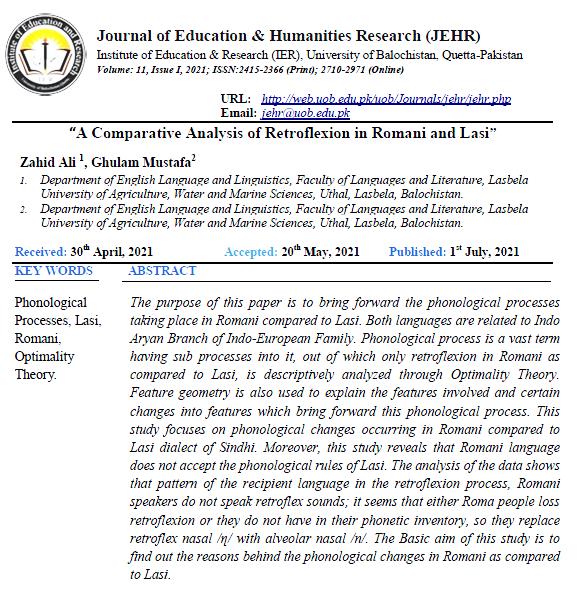A Comparative Analysis of Retroflexion in Romani and Lasi
NA
Keywords:
Phonological Processes, Lasi, Romani, Optimality TheoryAbstract
The purpose of this paper is to bring forward the phonological processes taking place in Romani compared to Lasi. Both languages are related to Indo Aryan Branch of Indo-European Family. Phonological process is a vast term having sub processes into it, out of which only retroflexion in Romani as compared to Lasi, is descriptively analysed through Optimality Theory. Feature geometry is also used to explain the features involved and certain changes into features which bring forward this phonological process. This study focuses on phonological changes occurring in Romani compared to Lasi dialect of Sindhi. Moreover, this study reveals that Romani language does not accept the phonological rules of Lasi. The analysis of the data shows that pattern of the recipient language in the retroflexion process, Romani speakers do not speak retroflex sounds; it seems that either Roma people loss retroflexion or they do not have in their phonetic inventory, so they replace retroflex nasal /ղ/ with alveolar nasal /n/. The Basic aim of this study is to find out the reasons behind the phonological changes in Romani as compared to Lasi.
References
Allen, W. S. (1953). Phonetics in ancient India (Vol. 1). Oxford University Press.
Allana, A. G. (1995). Sindhi boli ji lisani geography. Institution of Sindhology, University of Sindh Jamshoro.
Allana, A. G. (2009 A). Sindhi language and literature at glance. Sindhi Language Authority Hyderabad ISBN 969-8194-78-9.
Andvik, E. (2003). Tshangla. The Sino-Tibetan Languages, ed. by Graham Thurgood and Randy LaPolla, 439-455.
Archangeli, D. (1997). Optimality Theory: An introduction to linguistics in the 1990s. Optimality theory: An overview, 1-32. Allen, W. S. (1950). Notes on the phonetics of an Eastern Armenian speaker. Transactions of the Philological Society, 49(1), 180-206
Arsenault, P. (2012). The Diachronic Origins of Retroflex Phonotactics. Canadian Linguistic Association Conference, Wilfrid Laurier University, Waterloo.
Balasubramanian, T. (1972). The phonetics of colloquial Tamil (Doctoral dissertation, University of Edinburgh).
Baloch, N. A. (1973). 2nd edition, Belan ja bola. Zeb Adabi Merkz Hyderabad Sindh.
Baloch, N. A. (2008). Belan ja bola. Sindhi Sehat Gehar Hyderabad Sindh.
Bakst, S. (2012). Rhotic and retroflexes in Indic and Dravidian. University of Cambridge
Beames, J. (1875). Comparative Grammar of the Modern Aryan Languages of India. London, Trübner & Co
Bhat, D. N. S. (1973). Retroflexion: An Areal Feature. Working Papers on Language Universals, No. 13.
Bhat, D. N. S. (1974). Retroflexion and retraction. Journal of Phonetics, 2(3), 233-237.
Bhat, D. N.S. (1967). Descriptive analysis of Tulu (Vol. 15). Deccan College Post-graduate and Research Institute
Blood, D. L. (1967). Phonological units in Cham. Anthropological Linguistics, 15-32.
Blake, B. J., & Breen, J. G. (1971). The Pitta-pitta dialects. Monash University.
Boersma, P., & Hamann, S. (2005). The violability of backness in retroflex consonants. Rutgers Optimality Archive, 713.
Clements, N. (2004). Features and sound inventories. In Symposium on Phonological Theory: Representations and Architecture (pp. 20-21). New York: CUNY.
Clements, G. N., & Hume, E. V. (1995). The internal organization of speech sounds. In J. Goldsmith (Ed.), A handbook of phonological theory (pp. 245-306). Oxford: Blackwell.
Clements, G. (1985). The Geometry of Phonological Features. In C. Ewen & E. Kaisse (eds.), Phonology Yearbook II 225-252. Cambridge: Cambridge University Press.
Davenport, M. & Hannahs, S. J. (2013). Introducing phonetics and phonology (third edition) Rutledge Taylor & Francis Group London and New York.
Dixit, R. P. (1990). Linguotectal contact patterns in the dental and retroflex stops of Hindi. Journal of Phonetics, 18(2), 189-201.
Dixit, R. P., & Flege, J. E. (1991). Vowel context, rate and loudness effects of linguopalatal contact patterns in Hindi retroflex. Journal of Phonetics, 19(2), 213-229.
Dutta, H. (2012). Spirantization and the Notion of Phonological Strength Relations in Assamese: An Optimality Theoretic Account. Journal of Universal Language, 13(1), 71-99.
Emeneau, M. B. (1969). Onomatopoetics in the Indian linguistic area. Language, 274-299.
Flemming, E. (2003). The relationship between coronal place and vowel backness. Phonology, 20(3), 335-373.
Gair, J. W., & Paolillo, J. C. (1997). Sinhala. Lincom Europa.
Genetti, C. (2007). A grammar of Dolakha Newar (Vol. 40). Walter de Gruyter.
Glasgow, D., & Glasgow, K. (1967). The phonemes of Burera. Pacific Linguistics. Series A. Occasional Papers, (10), 1.
Gnanadesikan, A. (1994). The geometry of coronal articulations. In NELS (Vol. 24, No. 1, pp. 125-139).
Goldsmith, J. A. (1995). Phonological theory. The handbook of phonological theory, 1, 23.
Grierson, G. A. (1919). Linguistics survey of India. Vol- 8 (part 1) Indo-Aryan family north western group. Specimens of Sindhi and Lahnda language. Compiled and edited by G. A. Grierson. Low- price publications Delhi-110052. (first published 1919 reprinted LPP.1990,1994,2005).
Gulya, J. (1966). Eastern ostyak chrestomathy (Vol. 51). Indiana University.
Hall, T. A. (1997). The historical development of retroflex consonants in Indo-Aryan. Lingua, 102(4), 203-221.
Hall, T. A. (1997). The Phonology of Coronals (Vol. 149). Amsterdam: John Benjamin.
Hamann, S. (2005). The diachronic emergence of retroflex segments in three languages. Link, 15(1), 29-48.
Hazara, Z. A. (2011). (Additional Chief Secretary) Development, District Development profile. UNICEF Provincial Office Baluchistan, Quetta.
Heath, J. (1980). Basic materials in Ritharngu: Grammar, texts and dictionary. Department of Linguistics, Research School of Pacific Studies, The Australian National University.
Jennifer, S. C. (2006). The Sindhi language. In In K. Brown (ed.) Encyclopedia of Language and Linguistics (2 ed., Vol. 11, pp. 384-386). Oxford: Elsevier.
Jatoi, A. N. (1996). Sindhi Boli jo Lisani Jaezo (3 ed.). Jamshoro: Sindh Text Book Board, Hyderabad Sindh.
Kaufman, T. (1969). Teco: A new Mayan language. International Journal of American Linguistics, 35(2), 154-174




